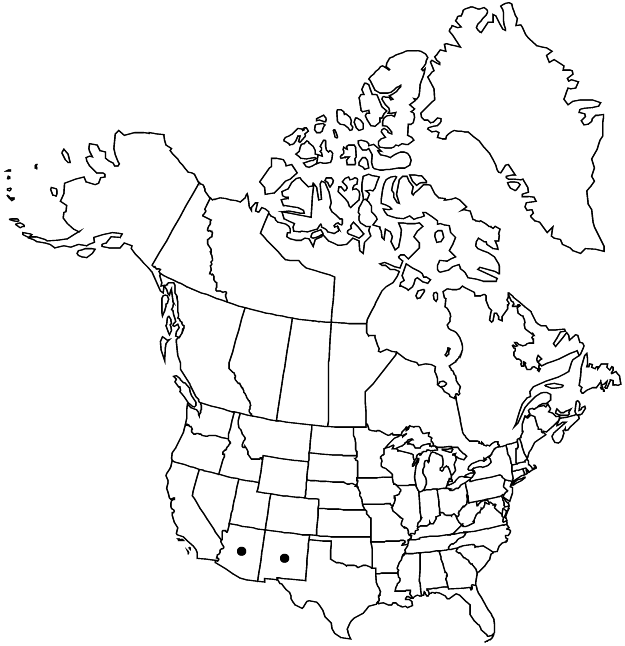Difference between revisions of "Cerastium texanum"
Bull. Torrey Bot. Club 15: 97. 1888.
FNA>Volume Importer |
FNA>Volume Importer |
||
| Line 12: | Line 12: | ||
|name=Cerastium longepedunculatum var. sordidum | |name=Cerastium longepedunculatum var. sordidum | ||
|authority=(B. L. Robinson) Briquet | |authority=(B. L. Robinson) Briquet | ||
| − | }}{{Treatment/ID/Synonym | + | }} {{Treatment/ID/Synonym |
|name=Cerastium sordidum | |name=Cerastium sordidum | ||
|authority=B. L. Robinson | |authority=B. L. Robinson | ||
| − | }}{{Treatment/ID/Synonym | + | }} {{Treatment/ID/Synonym |
|name=Stellaria montana | |name=Stellaria montana | ||
|authority=Rose | |authority=Rose | ||
| Line 33: | Line 33: | ||
|elevation=1200-2800 m | |elevation=1200-2800 m | ||
|distribution=Ariz.;N.Mex.;Mexico. | |distribution=Ariz.;N.Mex.;Mexico. | ||
| − | |discussion=<p>Cerastium texanum is exceptionally variable in flower and capsule size. The extent to which this variation is due to environmental conditions or is genic in origin is not known. The broad, spatulate basal leaves and the straight, cylindric capsule with its outwardly coiled (revolute) teeth distinguish this species.</p> | + | |discussion=<p><i>Cerastium texanum</i> is exceptionally variable in flower and capsule size. The extent to which this variation is due to environmental conditions or is genic in origin is not known. The broad, spatulate basal leaves and the straight, cylindric capsule with its outwardly coiled (revolute) teeth distinguish this species.</p> |
|tables= | |tables= | ||
|references={{Treatment/Reference | |references={{Treatment/Reference | ||
| Line 60: | Line 60: | ||
|publication year=1888 | |publication year=1888 | ||
|special status= | |special status= | ||
| − | |source xml=https://jpend@bitbucket.org/aafc-mbb/fna-data-curation.git/src/ | + | |source xml=https://jpend@bitbucket.org/aafc-mbb/fna-data-curation.git/src/8f726806613d60c220dc4493de13607dd3150896/coarse_grained_fna_xml/V5/V5_188.xml |
|subfamily=Caryophyllaceae subfam. Alsinoideae | |subfamily=Caryophyllaceae subfam. Alsinoideae | ||
|genus=Cerastium | |genus=Cerastium | ||
Revision as of 18:37, 18 September 2019
Plants annual, with slender taproot and branched caudex. Stems erect, sparingly branched proximally, slender, 15–35 cm, sparsely glandular-pilose; small axillary tufts of leaves absent. Leaves not marcescent; proximal blades broadly spatulate-petiolate, 8–55 × 3–16 mm, apex acute or obtuse, sometimes short-acuminate, softly pilose; cauline few, sessile, blade linear-lanceolate to narrowly oblanceolate, 7–30 mm, apex acute, pilose. Inflorescences very open and loose, 2–9(–25)-flowered cymes; bracts narrowly lanceolate, pilose. Pedicels straight, becoming sharply deflexed at base, slender, 5–20 mm, elongating in fruit, 1.5–4 times as long as sepals, glandular-pilose. Flowers: sepals green, turning pale orange-brown in fruit, lanceolate to ovate, 3–6 mm, margins narrow, apex acute, with short, glandular pubescence; petals oblanceolate, 5–8 mm, 1.5–2 times as long as sepals, apex 2-fid; stamens 5; styles 5. Capsules cylindric, straight, 5–12 mm, 1.5–2 times as long as sepals; teeth 10, becoming outwardly coiled. Seeds red-brown, 0.4–0.7 mm diam., tuberculate; tubercles ± pointed; testa not inflated. 2n = 36.
Phenology: Flowering spring.
Habitat: Canyons, sandy washes, oak woodlands, mountain pine forests
Elevation: 1200-2800 m
Distribution

Ariz., N.Mex., Mexico.
Discussion
Cerastium texanum is exceptionally variable in flower and capsule size. The extent to which this variation is due to environmental conditions or is genic in origin is not known. The broad, spatulate basal leaves and the straight, cylindric capsule with its outwardly coiled (revolute) teeth distinguish this species.
